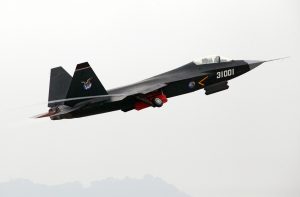On December 26, 2024, China carried out the test flights of its J-36 and J-XX fighter jets. It was Chairman Mao’s birthday that day, and the Chinese used the occasion to mark a huge milestone in their development of air fighting capability.
The J-36 and J-XX are tailless sixth-generation fighter jets. By revealing their prototypes, China signaled that it has surpassed both U.S. and Russian technologies by integrating AI, improved stealth, “hypersonic speeds, and advanced weaponry.” Not only do the two sixth-generation fighter aircraft have power generation capabilities that hover around the 1 MW mark, but also their integrated networked system could change the power dynamics in the Indo-Pacific.
This is the first time that a country has developed more advanced aircraft technology than the United States since the end of World War II. It could mark the start of a significant shift in regional and global air power dynamics, especially given that U.S. military dominance depends on mastery of the air.
The new jets’ combat reach can exceed 2,500 kilometers, meaning they can reach U.S. military stations in Guam, Diego Garcia, and even Alaska.
The sixth-generation fighters are expected to move at speeds beyond Mach 2, and with design tweaks, they can reach top speeds closer to Mach 3, especially at high altitudes where the air is thinner. They are designed to act as a main node in a cluster of unmanned systems like drones that would operate many kilometers in front of the aircraft. By integrating manned and unmanned systems, including Unmanned Combat Aerial Vehicles (UCAVs) acting as loyal wingmen, Chinese designers have increased the effective combat range of the aircraft by several hundred kilometers.
The J-36 and J-XX prototypes are much larger than the U.S. F-35s or F-22s. The Chinese believe that the newer generations of U.S. fighters are too small, limiting the amount of fuel they can carry and their capacity to generate power, which is vital for operating advanced electronic systems. The diamond-shaped and tailless aircraft are designed for long-range stealth and high survivability in contested environments and feature a triple-engine layout. These suggest an emphasis on both raw speed and the heavy electrical demands of future combat.
The massive internal volume of the Chinese sixth-generation aircraft indicates that their power generation capabilities are much more than their U.S. counterparts’. The Chinese believe that modern combat demands an electrical platform that can power high-energy radars, energy weapon (EW) systems, and even potential directed energy weapons (DEW).
Over the past few decades, U.S. designers have placed heavy emphasis on maneuverability, and systems like the F-35 have struggled with scaling electrical power. The high power capacity of the Chinese sixth-generation fighter is crucial for sensor fusion, real-time data processing, and leading UCAV swarms in network-centric battles, where rapid computation and electronic warfare are decisive.
Given that the sixth-generation aircraft command a host of supportive drones they present a significant to challenge the ability of traditional air forces to defend against them. As China continues to modernize its military forces, and integrates carrier-based aircraft, hypersonic missiles, and advanced EW drones, the strategic balance in the Indo-Pacific could tip significantly in Beijing’s favor.
For regional players, particularly India, China’s sixth-generation fighters represent a significant strategic challenge. India currently has fourth-generation aircraft. During Indian Prime Minister Narendra Modi’s recent visit to the United States, President Donald Trump said that the U.S. is willing to sell India fifth-generation F-35 aircraft.
Based on the time China took to develop its fourth- and fifth-generation aircraft from prototype to production, it is likely that the two Chinese sixth-generation fighters might join China’s Air Force by 2031. Indian acquisition of the U.S. F-35s is therefore a waste of money.
Given that India already grapples with a two-generation gap in fighter technology compared to China, accelerating its indigenous programs like the Advanced Medium Combat Aircraft (AMCA) or seeking deeper defense partnerships may soon become a strategic imperative.
However, even these defense partnerships may not suffice as it would take the U.S. at least 12 years to start producing a sixth-generation fighter (based on the timeline of F-22s and F-35s). India will therefore have to deal with the air dominance of Chinese sixth-generation fighters for at least six years.
Additionally, India is constrained by a limited number of forward airbases and has limited aerial refueling infrastructure. It seems obvious that India would struggle to counter aircraft that can operate deep into the Indian Ocean, which allows Beijing to project power over critical maritime chokepoints and exert pressure on regional air defenses.
China’s approach to sixth-generation aviation is emblematic of a broader shift in tactical military thinking. The emphasis is now on creating a networked combat ecosystem where manned aircraft serve as the central command node that coordinates with a range of supportive assets, from unmanned drones to long-range missile platforms. Such a doctrine forces China’s opponents to confront a multidomain threat where the lines between air, space, and cyber warfare are blurred.
China’s unveiling of the sixth-generation fighters, along with its recent advances in AI, semiconductors, and 6G sends a clear message to other powers. The coming decade is likely to see a dramatic realignment of military power in Asia, with China at the top of the fighter aircraft pecking order.

































